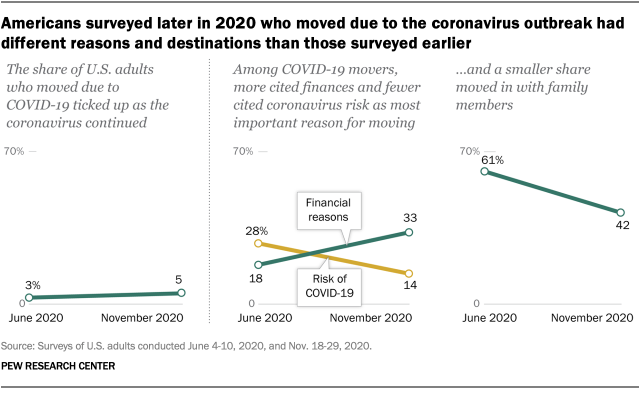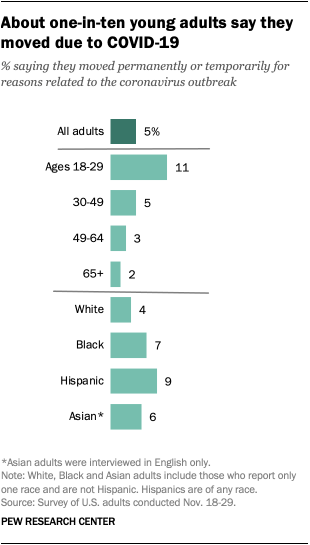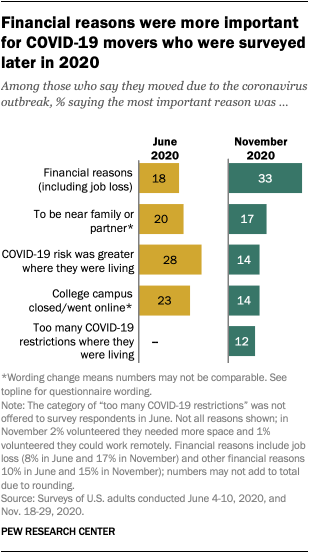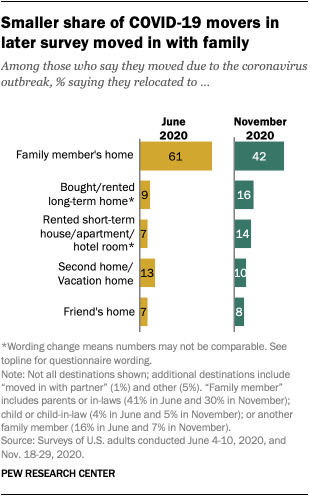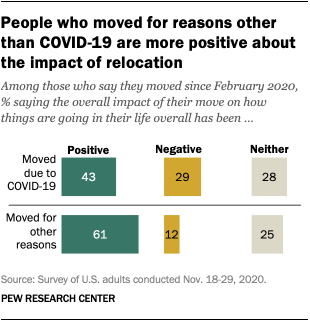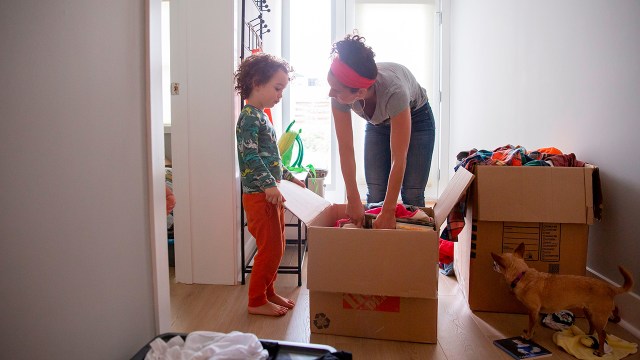
When COVID-19 began spreading across the United States early last year, millions of people fled communities where they feared getting infected or headed home from closed-down college campuses. As lockdowns and economic pain dragged on, pandemic migrants surveyed last fall were more likely than those interviewed in the spring to have relocated due to financial stress and less likely to cite risks of getting the coronavirus, according to a new Pew Research Center survey.
The survey also found that where people moved changed over the course of the pandemic. In November, a smaller share of those who moved because of the coronavirus outbreak said they had moved in with a family member than was the case in a June survey.
Following the coronavirus outbreak, a sizable share of Americans relocated for a variety of pandemic-related reasons. This research sought to trace how the dynamics behind decisions to move changed over time. To do so, 12,648 U.S. adults were surveyed from Nov. 18-29, 2020, and the results were compared with those from a survey conducted June 4-10, 2020. Everyone who took part is a member of Pew Research Center’s American Trends Panel (ATP), an online survey panel that is recruited through national, random sampling of residential addresses. This way nearly all U.S. adults have a chance of selection. The survey is weighted to be representative of the U.S. adult population by gender, race, ethnicity, partisan affiliation, education and other categories. Read more about the ATP’s methodology.
This survey includes a total sample size of 372 Asian Americans. The sample includes English-speaking Asian Americans only and, therefore, may not be representative of the overall Asian American population (72% of our weighted Asian American sample was born in another country, compared with 77% of the Asian American adult population overall). Despite this limitation, it is important to report the views of Asian Americans on the topics in this study. As always, Asian Americans’ responses are incorporated into the general population figures throughout this report. Because of the relatively small sample size and a reduction in precision due to weighting, we are not able to analyze Asian American respondents by demographic categories, such as gender, age or education. For more, see “Polling methods are changing, but reporting the views of Asian Americans remains a challenge.”
“Middle income” is defined here as two-thirds to double the median annual family income for panelists on the American Trends Panel after adjusting for differences in purchasing power by geographic region and for household size. “Lower income” falls below that range; “upper income” falls above it. In this sample, 32% are lower income, 45% are middle income and 19% fall into the upper-income tier. An additional 4% either didn’t offer a response to the income question or the household size question. For more information about how the income tiers were determined, please visit this link.
Here are the questions used for the November survey, along with responses, and its methodology.
One-in-twenty U.S. adults (5%) said they personally moved out of where they were living either permanently or temporarily due to the COVID-19 outbreak, according to the new survey conducted Nov. 18-29, 2020. That is somewhat higher than the 3% who said so in a survey in June. In the November survey, a total 10% of adults said they either moved or had someone else move in with them due to the coronavirus outbreak, up slightly from 8% in June.
Young adults ages 18 to 29 were more likely than any other age group in both surveys to have moved due to the outbreak – 11% said they did in the November survey. Adults in lower-income households (9%) were more likely to say they moved due to the virus than those with middle (3%) or upper incomes (4%). Hispanic (9%) and Black (7%) adults were more likely than those who are White (4%) to say this.
Financial reasons cited more often than in June
In November, a third of U.S. adults who moved due to the pandemic cited financial problems as the most important reason they relocated (17% said job loss and 15% said financial problems other than job loss). That compares with 18% who cited job loss or other financial reasons in June.
Other reasons cited in November included wanting to be near family or a partner (17%, vs. 20% who said they wanted to be near family in June) and the higher risk of coronavirus where they had been living (14% vs. 28% in June). Additional causes were their college campus closing or courses going online (14% in November vs. 23% who said in June they moved because their campus closed) and too many restrictions due to COVID-19 where they lived (12%, a category not asked about in the June survey). Other people who moved due to the virus said the main reason was that they needed more space (2%) or were able to work remotely (1%).
According to U.S. adults who had someone move in with them due to the coronavirus outbreak, financial problems were a notable reason given by the person who moved. About a third (36%) of those who had someone move in with them due to the outbreak said that money troubles (including job loss) were the main reason their new housemate left where they had been living. Other reasons included being near family or a partner (18%), the risk of COVID-19 where they were living (14%), a college campus closing or going online (13%) and too many restrictions due to the outbreak (9%).
Smaller share in later survey said they moved in with family
Among those who moved due to the coronavirus outbreak, 42% said they relocated to the home of a family member, down from 61% who said so in June. Three-in-ten of those who moved due to the outbreak went to their parents’ or in-laws’ home, according to the November survey. The rest went to the home of a child, child’s spouse or another unspecified family member.
One factor behind the shift in where Americans moved due to the coronavirus could be that more of them bought or rented their own homes, rather than moving in with others. In November, 30% of pandemic movers said they either rented a new home on “a short-term basis” (14%) or bought or rented one “on a long-term basis” (16%). In June, 16% said they rented a new home “for this period” or bought or rented a new home “to continue living in after this period.” (A difference in question wording between the June and November surveys prevents an exact comparison.)
About one-in-ten of those who moved due to the pandemic relocated to a vacation home (10%) or friend’s home (8%), according to the November survey.
Among the 6% of adults who said someone else moved in with them due to the coronavirus outbreak, family remained the most common group to do so. About half (51%) said an adult child or child’s spouse moved in with them, and about a quarter (23%) said a parent or parent-in-law did. The rest included a friend (29%), romantic partner (24%) or someone else (35%). (Some people had more than one person move in with them.)
The large share who had adult children move into their households reflects a broader societal trend. A Pew Research Center analysis found that a majority of young adults were living with their parents in July, the highest share since the Great Depression. Among those who had an adult child move in (and no one else), 27% said in November it was because their college closed or went online.
Some people have moved back
Most coronavirus migrants have not returned to where they had been living before the pandemic, according to the new survey. Of those who moved due to COVID-19, 69% said they reside in a different home than where they lived before. This includes 40% who are in a different community and 29% who are living in the same community where they lived before but in a different home.
About three-in-ten (31%) of those who moved due to the coronavirus outbreak said they are back in the same home where they had been living before the pandemic.
Likewise, a majority (58%) of those who had people move in with them due to the pandemic said at least one of them is still there. About four-in-ten (39%) said that they now have no one living with them who had moved in due to the coronavirus.
People who relocated for pandemic-related reasons are less likely than other movers to see their move as positive
The survey also included people who moved between February and November 2020 for reasons other than the coronavirus outbreak. Not surprisingly, coronavirus migrants are less likely than other Americans who relocated to have said their change of residence had a positive impact on their lives.
Only about four-in-ten (43%) of those who moved due to the coronavirus outbreak said it had a positive impact, compared with about six-in-ten adults (61%) who said they moved since last February for reasons unrelated to the pandemic. The share of pandemic-induced movers who said that relocation had a negative impact (29%) was higher than the share of other movers (12%) who said so.
Note: Here are the questions used for this report, along with responses, and its methodology.
